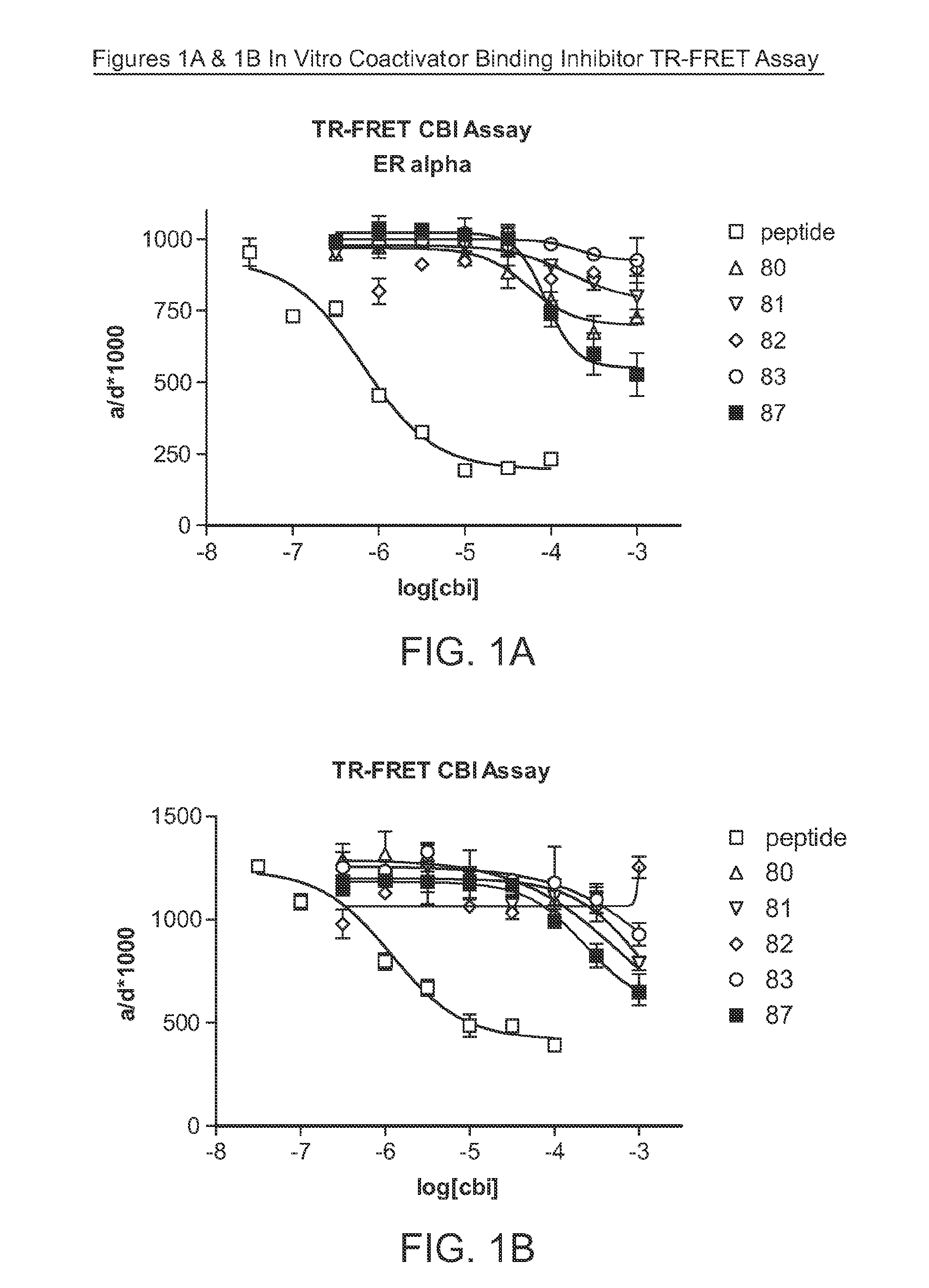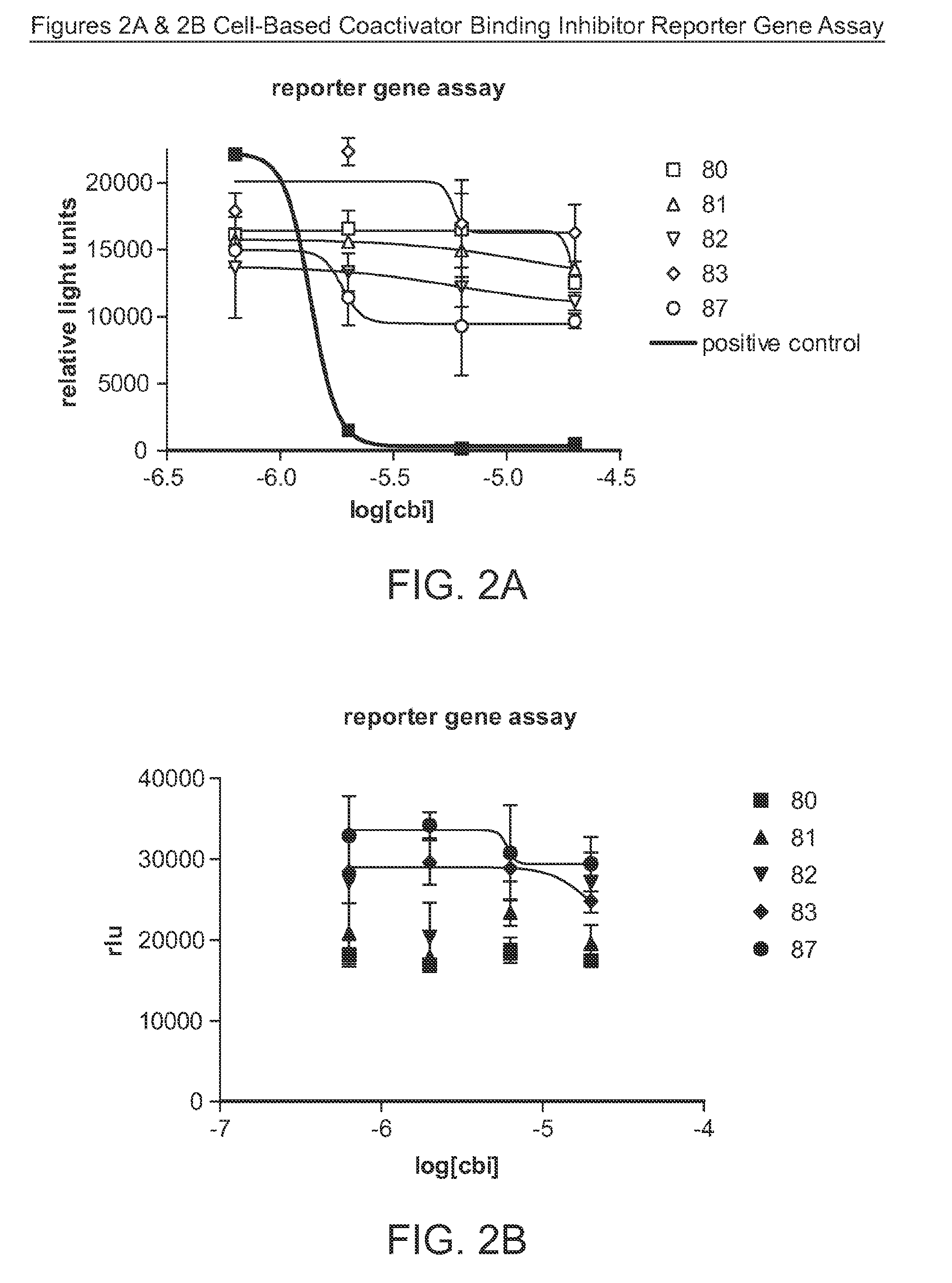Modulators of nuclear receptor co-regulatory protein binding
a nuclear receptor and co-regulatory protein technology, applied in the field of medical chemistry and biology, can solve the problems of limiting the effectiveness of non-ar-targeted therapy, limiting the effect of ar-targeted therapy, and largely unaffected others, so as to effectively block the interaction and effectively block the interaction
- Summary
- Abstract
- Description
- Claims
- Application Information
AI Technical Summary
Benefits of technology
Problems solved by technology
Method used
Image
Examples
example 1
Testing of Compounds
[0150]Some compounds of this disclosure were tested in two of the assays used to evaluate coactivator binding inhibitor activity and a radiometric binding assay to determine the potential of the compounds to act as ligands. The compounds tested are shown in Table 1.
TABLE 1PW-83 PW-80 AW-87 AW-82 PW-81R = H R = isopropyl R = sec-butyl R = tert-butyl R = benzylPW-82 PW-76 AW-79 AW-72 PW-78R = H R = isopropyl R = sec-butyl R = tert-butyl R = benzylAW-84 PW-74 AW-78 AW-73 PW-77R = H R = isopropyl R = sec-butyl R = tert-butyl R = benzyl
1. Coactivator Binding Inhibition Assays: In Vitro (TR-FRET) and in Cells (Reporter Gene)
[0151]The protocols for both the time-resolved fluorescence resonance energy transfer (TR-FRET) assay and the cell-based reporter gene assay can be found in Parent, et al. (2008) J. Med. Chem. 51(20):6512-30. A 15-mer SRC1-Box II peptide and a published guanylhydrazone CBI (Lafrate et al., (2008) Bioorg. Med. Chem. 2008:16(23)) were used as positive...
example 2
Evaluation of Compounds as Selective Inhibitors of AR-Coactivator and ER-Coactivator Binding
[0177]The compounds of this disclosure are analyzed for selectivity for AR and / or ER. For controls, peptide sequences are obtained that are selective for each of the nuclear receptors tested. Negative controls consist of vehicle and a random sequence helical peptide. The results are graphed, and Ki values determined from the curves for each compound and peptide tested. Compounds with Ki values in the 0.05-1.0 μM range and AR and / or ER selectivity in the 10-20-fold range are expected.
example 3
Evaluation of Compounds in AR-Responsive and AR-Independent Cells as Inhibitors of Cell Proliferation
[0178]Compounds of this disclosure that are selective inhibitors of AR-coactivator binding are evaluated initially in prostate cancer cell lines (PC-3 and DU-145) as inhibitors of cell proliferation. These two cell lines are standard lines for evaluating AR-mediated effects, the former being AR-positive and the latter being AR-independent. Both lines are examined in the presence or absence of androgens, anti-androgens and vehicle to determine the effects of the compounds of this disclosure and whether the responses are mediated through co-activator or co-repressor binding sites. The responses of the compounds on other non-prostate cancer cell lines, such as normal fibroblasts and breast cancer (MCF-7) cells, are used to illustrate their selectivity for prostate cancer. In addition to determining the anti-proliferative response, the effect of the compounds on cellular proteins using g...
PUM
| Property | Measurement | Unit |
|---|---|---|
| weight percent | aaaaa | aaaaa |
| volume | aaaaa | aaaaa |
| pH | aaaaa | aaaaa |
Abstract
Description
Claims
Application Information
 Login to View More
Login to View More - R&D
- Intellectual Property
- Life Sciences
- Materials
- Tech Scout
- Unparalleled Data Quality
- Higher Quality Content
- 60% Fewer Hallucinations
Browse by: Latest US Patents, China's latest patents, Technical Efficacy Thesaurus, Application Domain, Technology Topic, Popular Technical Reports.
© 2025 PatSnap. All rights reserved.Legal|Privacy policy|Modern Slavery Act Transparency Statement|Sitemap|About US| Contact US: help@patsnap.com



